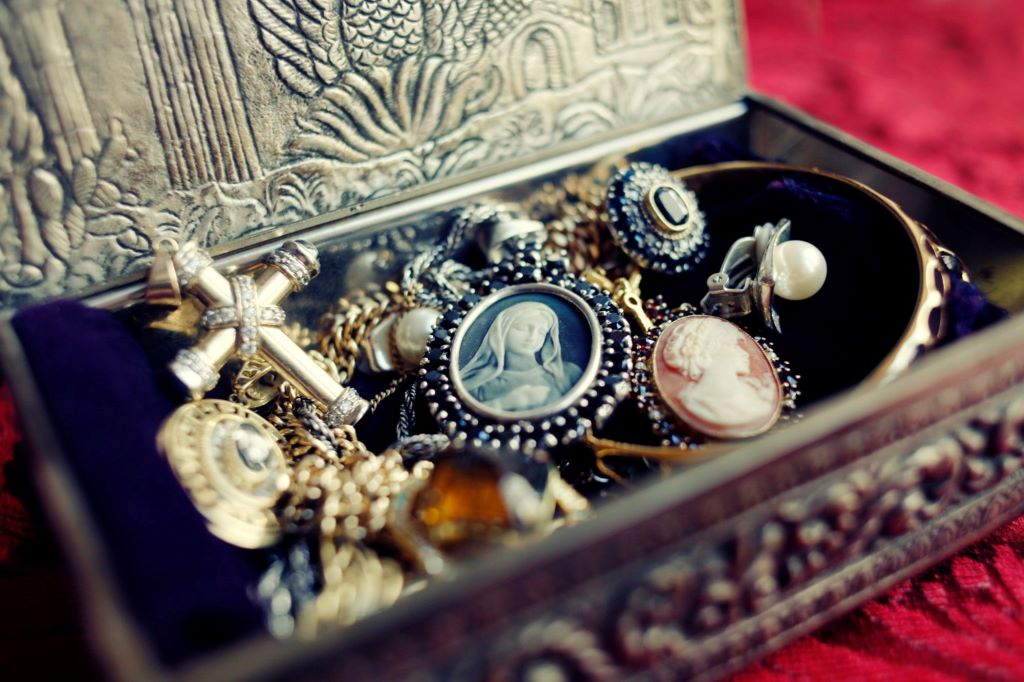
The Ultimate Guide to Men’s Clothing Fabrics: Comfort, Durability, and Style Combined
July 7, 2025
2025 Wedding Dress Trends Every Bride Should Know
July 20, 2025Picture this: a delicate Art Deco diamond ring catches the light as you move your hand, its geometric patterns telling a story that began nearly a century ago. This isn’t just jewelry—it’s a piece of history, a work of art, and surprisingly, one of the most sustainable luxury choices you can make today. As consumers become increasingly conscious of their environmental footprint, vintage and antique jewelry emerges as the perfect intersection of ethical consumption, timeless beauty, and investment-worthy luxury.
Table of Contents
ToggleThe Environmental Impact of Modern Jewelry Production
The traditional jewelry industry carries a heavy environmental burden that many consumers are only beginning to understand. Modern jewelry manufacturing involves extensive mining operations that disturb ecosystems, consume massive amounts of water, and generate significant carbon emissions. Gold mining, for instance, can produce up to 20 tons of waste rock for every ounce of gold extracted, while diamond mining operations often require moving tons of earth to find a single carat.
The environmental cost extends beyond extraction. Processing precious metals and gemstones requires energy-intensive refining processes, chemical treatments, and transportation across global supply chains. When you factor in the packaging, marketing, and retail distribution of new jewelry pieces, the carbon footprint becomes substantial.
Vintage and antique jewelry sidesteps these environmental concerns entirely. These pieces have already been created, their environmental impact absorbed decades or centuries ago. By choosing pre-owned luxury jewelry, you’re essentially recycling precious materials without requiring new mining or manufacturing processes. This circular economy approach transforms what was once considered purely aesthetic consumption into an environmentally responsible choice.
The Ethical Considerations of Jewelry Sourcing
Beyond environmental concerns, the jewelry industry grapples with complex ethical issues surrounding labor practices and conflict minerals. Despite improvements in certification processes and ethical sourcing initiatives, challenges persist in ensuring fair wages, safe working conditions, and community benefit in mining regions.
Vintage jewelry eliminates these modern ethical dilemmas. These pieces were created in different eras, often by skilled artisans who took pride in their craftsmanship. When you purchase antique jewelry, you’re not contributing to current problematic practices but rather preserving the work of previous generations. This temporal distance provides ethical clarity that’s difficult to achieve with contemporary pieces, even those marketed as ethically sourced.
The provenance of vintage pieces also offers transparency that’s often missing in modern jewelry supply chains. While you may not know the exact origin of every gemstone in an antique piece, you can trace its more recent history through previous owners, estate sales, and reputable dealers. This traceability creates a different kind of ethical assurance—one based on preservation rather than extraction.
Craftsmanship and Artistry: A Lost Art Reborn
One of the most compelling arguments for vintage and antique jewelry lies in the superior craftsmanship of bygone eras. Before mass production and machine manufacturing dominated the industry, jewelry was created by skilled artisans who learned their craft through apprenticeships spanning years or even decades. This human touch is evident in every detail, from hand-engraved patterns to the precision of stone settings.
Different historical periods brought distinct aesthetic movements that influenced jewelry design. The intricate filigree work of the Edwardian era, the bold geometric patterns of Art Deco pieces, and the organic forms of Art Nouveau jewelry each represent unique artistic expressions that reflected their times. These design movements created jewelry that was not just decorative but also culturally significant, capturing the spirit and values of their respective periods.
Modern jewelry production, while technologically advanced, often prioritizes efficiency and cost-effectiveness over artistic expression. Mass production techniques, while capable of creating consistent quality, rarely achieve the individual character and attention to detail found in handcrafted vintage pieces. When you wear vintage jewelry, you’re not just accessorizing—you’re carrying a piece of artistic heritage that connects you to the skilled hands that created it.
Investment Value and Financial Wisdom
Vintage and antique jewelry often represents a sound financial investment, combining the intrinsic value of precious materials with the added premium of historical significance and craftsmanship. Unlike many modern jewelry pieces that depreciate immediately upon purchase, well-chosen vintage items can maintain or even increase their value over time.
The investment potential of vintage jewelry stems from several factors. Rarity plays a crucial role—pieces from renowned jewelry houses, famous designers, or significant historical periods become increasingly scarce as time passes. This scarcity, combined with continued demand from collectors and fashion enthusiasts, creates upward pressure on prices.
Additionally, vintage jewelry often contains higher-quality materials than contemporary pieces. Gold jewelry from earlier eras frequently features higher karat ratings, while antique gemstones may have superior clarity and color compared to modern stones. The combination of superior materials and skilled craftsmanship creates pieces that not only retain their beauty but also their monetary value.
The resale market for vintage jewelry remains robust, with auction houses, specialized dealers, and online platforms providing multiple avenues for future liquidation. This liquidity, combined with the jewelry’s inherent value, makes vintage pieces a more practical investment than many other luxury goods.
Unique Style and Personal Expression
In a world of mass-produced fashion, vintage jewelry offers unparalleled uniqueness. Each piece carries its own history, character, and distinctive features that make it virtually impossible to replicate. This individuality allows wearers to express their personal style in ways that contemporary jewelry simply cannot match.
The diversity of vintage jewelry spans centuries of design evolution, offering options for every taste and occasion. Whether you prefer the romantic sensibility of Victorian mourning jewelry, the glamorous excess of 1920s cocktail rings, or the sleek modernism of mid-century pieces, vintage collections provide endless opportunities for personal expression.
Styling vintage jewelry also offers creative flexibility. These pieces can be worn traditionally to honor their historical context, or incorporated into contemporary outfits to create unexpected and striking combinations. A Victorian brooch can transform a simple blazer, while Art Deco earrings can add sophistication to a modern dress. This versatility makes vintage jewelry a valuable addition to any wardrobe.
Caring for Your Vintage Jewelry Investment
Proper care and maintenance are essential for preserving both the beauty and value of vintage jewelry. Unlike modern pieces designed for everyday wear, antique jewelry may require special attention due to its age and the materials used in its construction.
Understanding the specific needs of different metals and gemstones is crucial. Some antique pieces may feature materials or construction techniques that are sensitive to modern cleaning methods. Professional cleaning and regular maintenance by experienced jewelers familiar with vintage pieces can help preserve their integrity while maintaining their appearance.
Storage also plays a vital role in preservation. Vintage jewelry should be stored in appropriate conditions that protect against humidity, temperature fluctuations, and potential damage from contact with other pieces. Proper documentation of your collection, including photographs and provenance information, not only helps with insurance purposes but also contributes to the historical record of these important pieces.
Building a Sustainable Luxury Collection
Creating a collection of vintage and antique jewelry requires patience, knowledge, and careful consideration. Unlike purchasing new jewelry, building a vintage collection is a journey of discovery that unfolds over time. Each piece should be chosen not just for its immediate appeal but for its long-term significance within your collection.
Research becomes an essential skill for vintage jewelry collectors. Understanding different periods, recognizing quality craftsmanship, and identifying authentic pieces versus reproductions requires ongoing education. This knowledge not only helps in making informed purchases but also deepens appreciation for the pieces you own.
Building relationships with reputable dealers, auction houses, and estate sale specialists can provide access to exceptional pieces while ensuring authenticity and proper provenance. These professional relationships often lead to first opportunities to view and purchase significant pieces before they reach the broader market.
The Future of Sustainable Luxury
As environmental consciousness continues to grow, the luxury market is evolving to meet consumer demands for sustainable options. Vintage and antique jewelry represents the most established form of sustainable luxury, having proven its environmental and ethical benefits over decades of collecting and wearing.
The trend toward sustainable luxury extends beyond individual consumer choices to influence industry practices. Major jewelry brands are increasingly incorporating recycled materials, improving ethical sourcing, and even creating vintage-inspired collections that capture the appeal of historical pieces while addressing modern sustainability concerns.
However, nothing quite replaces the authenticity, craftsmanship, and environmental benefits of genuine vintage and antique jewelry. These pieces offer a path to luxury consumption that aligns with contemporary values while providing timeless beauty and lasting value.
Conclusion
Vintage and antique jewelry represents more than just sustainable luxury—it embodies a philosophy of thoughtful consumption that honors the past while protecting the future. By choosing these exceptional pieces, you’re making a statement about your values, your style, and your commitment to environmental responsibility.
The beauty of vintage jewelry lies not just in its aesthetic appeal but in its ability to tell stories, preserve craftsmanship, and provide lasting value. Each piece becomes a conversation starter, a work of art, and a testament to the skilled artisans who created it.
Ready to begin your sustainable luxury journey? Start exploring reputable vintage jewelry dealers, attend estate sales, and visit auction houses to discover the perfect pieces for your collection. Whether you’re seeking a statement necklace, an engagement ring with character, or simply want to add unique pieces to your jewelry box, vintage and antique jewelry offers unparalleled opportunities for sustainable luxury.
Take the first step toward building your own collection of meaningful, beautiful, and environmentally responsible jewelry. Your future self—and the planet—will thank you for choosing timeless pieces that celebrate both heritage and sustainability.
Read More:
Signet Rings for Women: An Emerging Trend in Modern Jewellery
The Best Fashion Stores in Greenwich Village: Your Guide to Stylish Shopping


